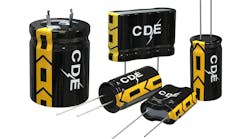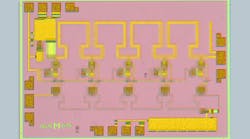Bandwidth is everything for some applications, including many communications systems, and boosting signal levels over broad bandwidths requires a special kind of amplifier. Typically, a distributed amplifier is used for such applications. As its name might suggest, gain is distributed among a number of transistors or active stages within the amplifier, such as field-effect transistors (FETs) in GaAs distributed amplifiers, to achieve level signal gain over wide bandwidths.
Commercially available amplifiers that deliver widely distributed gain with excellent gain flatness are the model CMD240 die, the CMD240P4 packaged amplifier (a CMD240 die mounted in a QFN package), the CMD242, and the CMD244 GaAs MMIC distributed amplifiers from Custom MMIC. These impedance-matched, 50-Ω dc-coupled amplifiers in their die and packaged forms are capable of bandwidths as wide as dc to 40 GHz in a single device (the model CMD242). They offer attractive combinations of low noise figures and flat-to-positive-sloping gain with frequency that remains stable with temperature.
Such amplifiers are invaluable for wideband communications receiver front ends. Their low noise figure doesn’t compromise receiver front-end sensitivity and they maintain sufficient gain to drive desired signals above the noise. In many cases, a single distributed amplifier may have sufficient bandwidth to serve multiple receive-frequency bands and receiver front ends if switched, helping to reduce the parts count on a portable radio design.
1. Model CMD240 is a GaAs MMIC distributed amplifier die with low noise figure and level gain from dc to 22 GHz.
For example, model CMD240 is a GaAs MMIC distributed amplifier die that delivers typically more than 15 dB gain while holding noise figure to typically 2.2 dB or less from dc to 22 GHz (Fig. 1). It provides +19 dBm typical output 1-dB compression point (output P1dB) and +28 dBm output third-order intercept point (IP3) across that wide frequency range when operating from +5 V dc drain voltage, −0.6 V dc gate voltage, and 80 mA typical current draw. Input return loss is typically 15 dB across the full dc to 22 GHz, while output return loss is typically 13 dB for the same range. The CMD240 has maximum rating of +20 dBm for input power.










